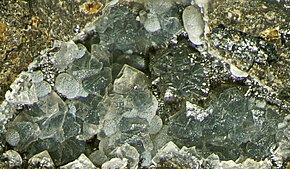
Back Faujasita Catalan Faujasit German Faujasita Spanish Faujasita EU Faujasite French フォージャサイト Japanese Faujasyt Polish Фожазит Ukrainian
| Faujasite | |
|---|---|
 | |
| General | |
| Category | Zeolite |
| Formula (repeating unit) | (Na2,Ca,Mg)3.5[Al7Si17O48]·32(H2O)[1] |
| IMA symbol | Fau[2] |
| Strunz classification | 9.GD.30 |
| Crystal system | Cubic |
| Crystal class | Hexoctahedral (m3m) H–M Symbol (4/m 3 2/m) |
| Space group | Fd3m |
| Unit cell | a = 24.638–24.65 Å, Z = 32 |
| Identification | |
| Color | Colorless, white |
| Crystal habit | Octahedral or rarely trisoctahedral crystals up to 4 mm in size |
| Twinning | on {111}, contact and penetration twins |
| Cleavage | {111}, perfect |
| Fracture | Uneven to conchoidal |
| Tenacity | Brittle |
| Mohs scale hardness | 4.5-5 |
| Luster | Vitreous to adamantine |
| Streak | White |
| Diaphaneity | Transparent |
| Specific gravity | 1.92–1.93 |
| Optical properties | Isotropic |
| Refractive index | n = 1.466–1.480 |
| Pleochroism | None |
| References | [3][4][5] |
Faujasite (FAU-type zeolite) is a mineral group in the zeolite family of silicate minerals. The group consists of faujasite-Na, faujasite-Mg and faujasite-Ca. They all share the same basic formula (Na2,Ca,Mg)3.5[Al7Si17O48]·32(H2O) by varying the amounts of sodium, magnesium and calcium.[1] Faujasite occurs as a rare mineral in several locations worldwide.
Faujasite materials are widely synthesized industrially. The relatively low-silica (Si/Al<2) synthetic faujasite is called Zeolite X and the high-silica (Si/Al>2) one is called Zeolite Y. In addition, the aluminum component in zeolite Y can be removed by acid-treatment and/or steam-treatment, and the resulting faujasite is called USY (Ultrastable zeolite Y). USY is used in fluid catalytic cracking process as a catalyst.
- ^ a b The Faujasite group on Mindat
- ^ Warr, L.N. (2021). "IMA–CNMNC approved mineral symbols". Mineralogical Magazine. 85 (3): 291–320. Bibcode:2021MinM...85..291W. doi:10.1180/mgm.2021.43. S2CID 235729616.
- ^ Faujasite. Handbook of Mineralogy.
- ^ Faujasite. Mindat.
- ^ Faujasite Mineral Data. Webmineral.